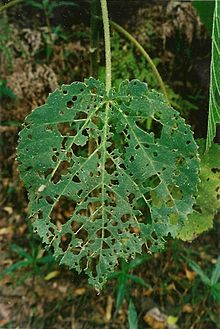Dendrocnide excelsa
| Dendrocnide excelsa | |
|---|---|

| |
| Chewed leaf of a Dendrocnide excelsa at Gumbaynggirr State Conservation Area, west of Nambucca Heads, Australia | |
| Scientific classification | |
| Kingdom: | Plantae |
| Clade: | Tracheophytes |
| Clade: | Angiosperms |
| Clade: | Eudicots |
| Clade: | Rosids |
| Order: | Rosales |
| Family: | Urticaceae |
| Genus: | Dendrocnide |
| Species: | D. excelsa
|
| Binomial name | |
| Dendrocnide excelsa | |
Dendrocnide excelsa, commonly known as the giant stinging tree or fibrewood, is a rainforest tree in the family Urticaceae which is endemic to eastern Australia. It occurs from Tathra, New South Wales to Imbil in southeastern Queensland, and is very common at Dorrigo National Park and other rainforest walks in eastern Australia. The habitat of the giant stinging tree is subtropical, warm temperate or littoral rainforest, particularly in disturbed areas, previously flattened by storms or cyclones. It is well known for its extremely painful, long-lasting sting.
Description
This section needs additional citations for verification. (April 2023) |
Dendrocnide excelsa is a medium to large-sized tree with a buttressed base, sometimes over 40 metres tall and in excess of 6 metres wide at the base. The DBH is up to 4.3 m (14.1 ft).[1]
The trunk can be fluted or flanged. The outer bark is grey and smooth, with minor corky markings. The trunk and buttresses are shaped in even curves. The leaves are alternate and toothed, heart-shaped and very large in positions of shade, exceeding 30 cm in length and a similar width. The sun leaves are smaller. The leaves, which are replete with stinging hairs, are eaten by various insects such as the chrysomelid beetle, and mammals.
Flowers appear from November to April, forming in short panicles. The fruit is a purple or blackish nut, maturing from March to August. The flesh is edible, but the danger of stinging hairs precludes human consumption. The fruit is eaten by many rainforest birds, including the regent bowerbird and the green catbird.
Sting
All aerial parts of the tree have stinging hairs, and can cause a severe reaction on contact with skin, so it is a hazard to livestock, travelers and campers. However, the tree is an important member of the ecosystems of eastern Australian forests. The sting is considered more severe than Dendrocnide photiniphylla (shining-leaved stinging tree), but not as severe as Dendrocnide moroides (gympie stinger).[citation needed] The tree delivers neurotoxin proteins which researchers named gympietides, similar to toxins found in spiders and cone snails, and not previously seen in plants.[2][3] It was postulated that the long-term pain from the gympietides may be due to permanent changes in the sodium channels in sensory neurons.[4]

The venom binds to and fires pain receptors in the nervous system; there are hopes that understanding how these proteins work could lead to the creation of new painkillers.[5]
Minor stings can last for an hour or two. However, severe stinging can last for months. First aid for the sting is to apply wax hair-removal strips and then yank them off to remove the trees' hairs.[6] Dendrocnide stings have been known to kill dogs and horses that have brushed against them.[6][7][unreliable source?]
It was found that even heavy welding gloves did not protect researchers from stings while studying the tree.[8]
Uses
Indigenous Australians used the fibres to make nets and lines.[citation needed]

References
- ^ Floyd, A.G. (1989). Rainforest Trees of Mainland Southeastern Australia. Melbourne: Inkata Press. p. 402.
- ^ "Neurotoxic peptides from the venom of the giant Australian stinging tree". Science Advances. 16 September 2020. Retrieved 20 October 2020.
- ^ "Why 'venomous' plant hurts so much". NewsComAu. 16 September 2020. Retrieved 20 September 2020.
- ^ "Native stinging tree toxins match the pain of spiders and scorpions". University of Queensland. 17 September 2020. Retrieved 22 September 2020.
- ^ Simons, Paul (20 October 2020). "Plantwatch: Australia's giant stinging trees – 35m tall with a poison that can last for months". The Guardian.
- ^ a b Hurley M (2000) Foliage Attributes and Growth Dynamics of Stinging Trees (Dendrocnide spp.) in northern Australian upland tropical rainforest: implications for herbivores. Australian Journal of Botany, 48:191-201.
- ^ "Dendrocnide". www.bio.davidson.edu. Retrieved 11 June 2010.
- ^ "Gympie Gympie: Once stung, never forgotten". Australian Geographic. 16 June 2009. Retrieved 20 September 2020.
